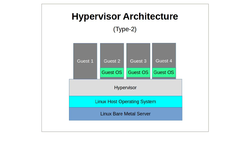Difference between revisions of "Broadband Server"
| Line 5: | Line 5: | ||
If you encounter any problems with the SCEC Broadband Server, or to request access, please contact software@scec.org. | If you encounter any problems with the SCEC Broadband Server, or to request access, please contact software@scec.org. | ||
| + | == Proposed Virtualized Server Software Stack == | ||
| + | To facilitate migrating our broadband server configuration, we will use a virtualized version of the system, with a host OS the runs the hypervisor, and a guest OS which we use to perform software development. | ||
| + | [[Image:Guest_host.png|left|250px]] | ||
| − | |||
| − | |||
| + | Based o our use of KVM, the resulting system will be considered a type 2 hypervisor system. | ||
| + | [[Image:Kvm_stack.jpg|right|250px]] | ||
== Host OS that include KVM == | == Host OS that include KVM == | ||
Revision as of 18:14, 21 October 2020
Contents
Overview
The SCEC Broadband server is a computing resource with the Broadband Platform platform pre-installed and configured. Access to this server is by request, and requires a login which is provided once your account has been activated.
If you encounter any problems with the SCEC Broadband Server, or to request access, please contact software@scec.org.
Proposed Virtualized Server Software Stack
To facilitate migrating our broadband server configuration, we will use a virtualized version of the system, with a host OS the runs the hypervisor, and a guest OS which we use to perform software development.
Based o our use of KVM, the resulting system will be considered a type 2 hypervisor system.
Host OS that include KVM
We want a recent version of CentOS as the Host OS
- CentOS
Guest OS for Broadband Server Configuration
We want a recent version of Ubuntu as the Guest OS. This should have a full set of software developer tools.
- Ubuntu 20.04 LTS
Configuration Details
- SSH access
- Accounts set up via LDAP server (Edric)
Software Stack
We would like these gnu compilers installed which are required to compile the Broadband Platform components:
- gcc and gfortran (9.3.0)
- fftw libraries (3.3.4 or later)
We would like the Python3 software installed using the Anaconda distribution tool. These are needed for running the Broadband Platform:
- Python3 (3.8.2)
- NumPy (1.17.4)
- SciPy (1.3.3)
- Matplotlib (3.1.2)
- PyProj (2.5.0)
- Numba (0.48.0)
Other tools/packages that should be installed on the system are:
- wget
- automake/autoconf
- awk/sed
- emacs
- git
Filesystems
These are local filesystems on the Broadband Server and they should be backed up periodically.
- /home/broadband-01 2.7T (2.5T Used, 0.2T Available)
- /home/broadband-02 3.6T (3.0T Used, 0.6T Available)
These are remote filesystems available from the Broadband Server, needed for Broadband work:
- /home/hypocenter-01 7.3T (2.6T Used, 4.8T Available, hypocenter.usc.edu:/hypocenter-01)
- /home/rcf-104 286T (248T Used, 38T Available, almaak-07.usc.edu:/export/samfs-scec0/rcf-104)
- /home/scec-00 286T (249T Used, 37T Available, almaak-07.usc.edu:/export/samfs-scec0/scec-00)
- /home/scec-01 13T (8.1T Used, 3.9T Available, arc.usc.edu:/scec-01)

